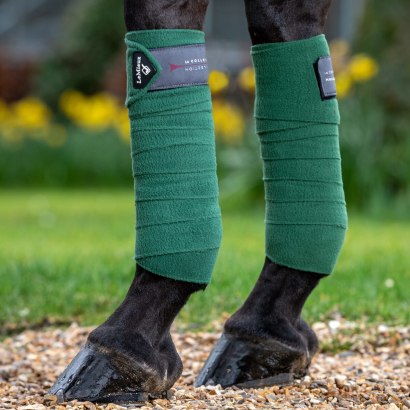How to Polo Wrap a Horse’s Legs
Updated November 2, 2023

Commonly called training bandages, polo wraps offer support and protection for horse’s lower legs during exercise. Polos are typically made of stretchy, soft fleece material and are available in a many different colors.
Knowing how to wrap a horse’s legs is an important stable skill for all riders to master. Follow these steps below to learn how to correctly put on a polo wrap and understand the differences with using polos versus boots.
Preparing to Polo Wrap Your Horse
There are a several basics of polo wrapping you should understand before you start rolling:
- The polos should not be too loose as it could slip down the leg and potentially cause your horse to spook or stumble. They should also not be too tight or wrapped with uneven pressure as that could cause damage to the soft tissues on the back of the leg.
- All wraps and boots are put on the legs with the material wrapping in the direction toward the back or tail of the horse.
- A correctly applied polo wrap should have evenly spaced overlaps and no wrinkles or bunching.
- Make sure all your wraps are rolled correctly (inside out) before you begin. Each polo should be rolled tightly and evenly before beginning to make it easier to unwrap on your horse’s legs.
- Your horse’s legs should be clean and dry.
- Make sure your horse is standing on level ground and is safely tied or held by someone.
- If you polo wrap one leg, be sure to also wrap the adjacent one. Wrapping both front and/or hind legs provides an even feel for your horse and consistent support for his legs.
Step-by-Step Guide to Polo Wraps

- Place the end of the polo wrap right below the knee or about midway down the cannon bone. Your starting point may change depending on the length of your wraps and height of your horse’s cannon bones.
- Keep the rolled-up portion of the polo toward the back of your horse’s leg and make sure the inside of the roll is facing you.
- You should have just enough of the polo out in front of the leg so that when you wrap it around to the inside, it ends in the little groove behind the cannon bone and in front of the tendons. You can adjust the length if necessary.
- Smoothly unroll the polo around the leg so that the first wrap covers the end.
- Once the end is secured, you can let go of it and begin wrapping down the leg.
- Try to maintain even tension on the polo as you wrap, neither tugging in places nor letting it go loose.
- Never pull the wrap tight when on the inside of the leg as this could damage the tendons by pulling them forward. Only tighten when the wrap is positioned on the front of the leg, so it’s pulling over the cannon bone toward the back.
- Each turn should cover about 50% of the material from the last turn.
- On the left legs, you’ll wrap in a counterclockwise direction, but for the right legs you’ll wrap clockwise.
- Once you reach the bottom of the leg, make a slight “sling” under the fetlock, and then continue wrapping back up the leg. This will create a slight “V” shape in the front of the leg.
- Continue wrapping back up the leg until you reach to right below the knee where you started.
- Fasten the Velcro securely.
Ask your trainer for help as you start learning how to polo wrap so you can get a feel for yourself under the watchful eye of a knowledgeable instructor.
Polos vs. Boots

Deciding whether to use a polo wrap, splint boots, sport medicine boots, or other leg bandages varies based on several factors, including:
- The horse’s age, breed, and conformation
- His use, level of training and conditioning (fitness)
- The footing or terrain
- The rider’s or handler’s preferences and experience level
- Existing medical issues with the hooves or limbs
Both wraps and boots protect horses from interference-type injuries. For example, wrapping or using boots on a 3-year-old horse being started under saddle may be helpful in preventing a hind foot from overreaching and striking a front foot, or one leg hitting another as your young horse develops his balance.
Since it is possible to cause harm by improperly applying polo wraps, those with little experience or guidance may want to consider using an easy to attach splint boot, open front boots or ankle boots as protection for your horse when you’re exercising him or he’s turned out.